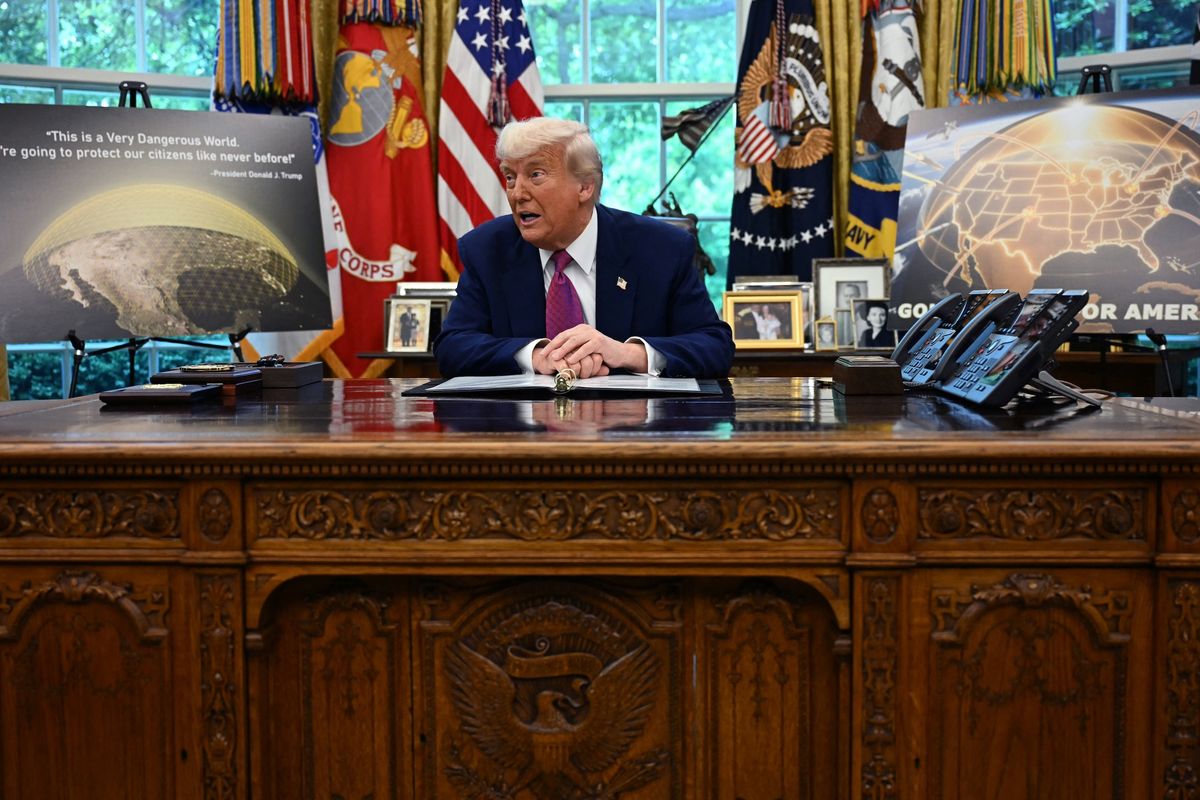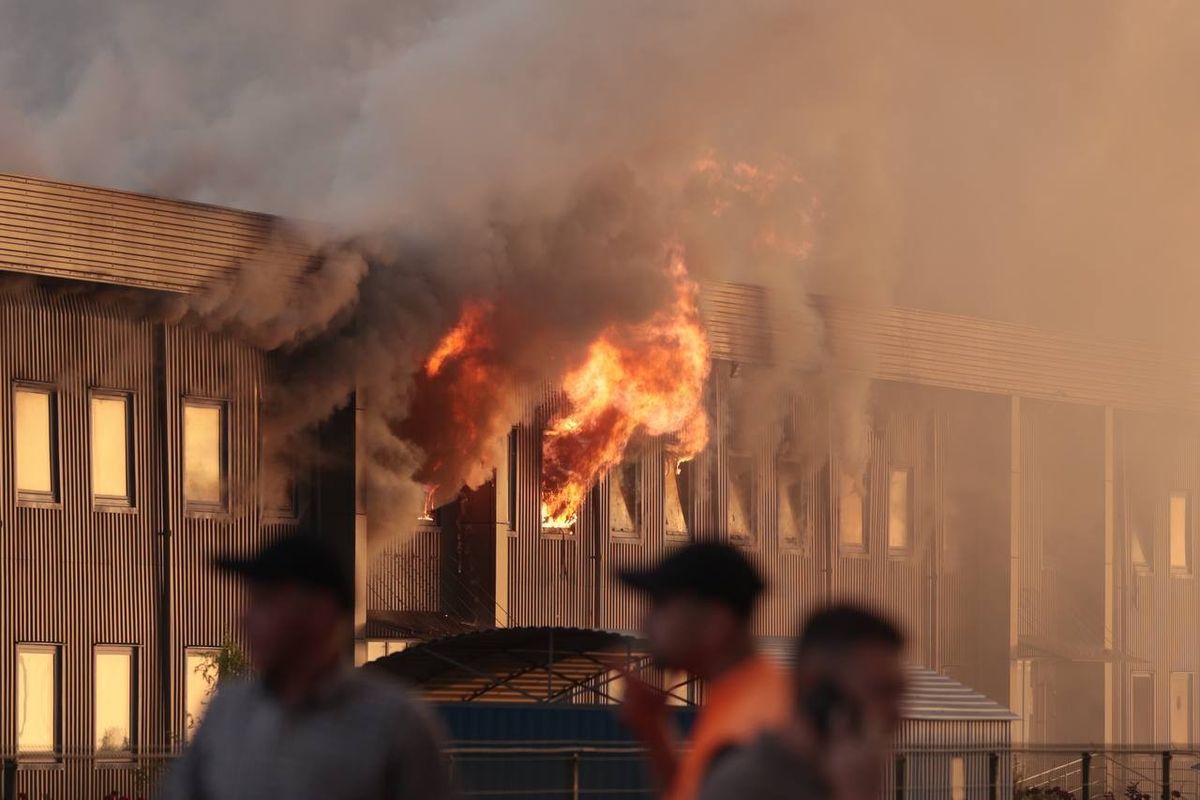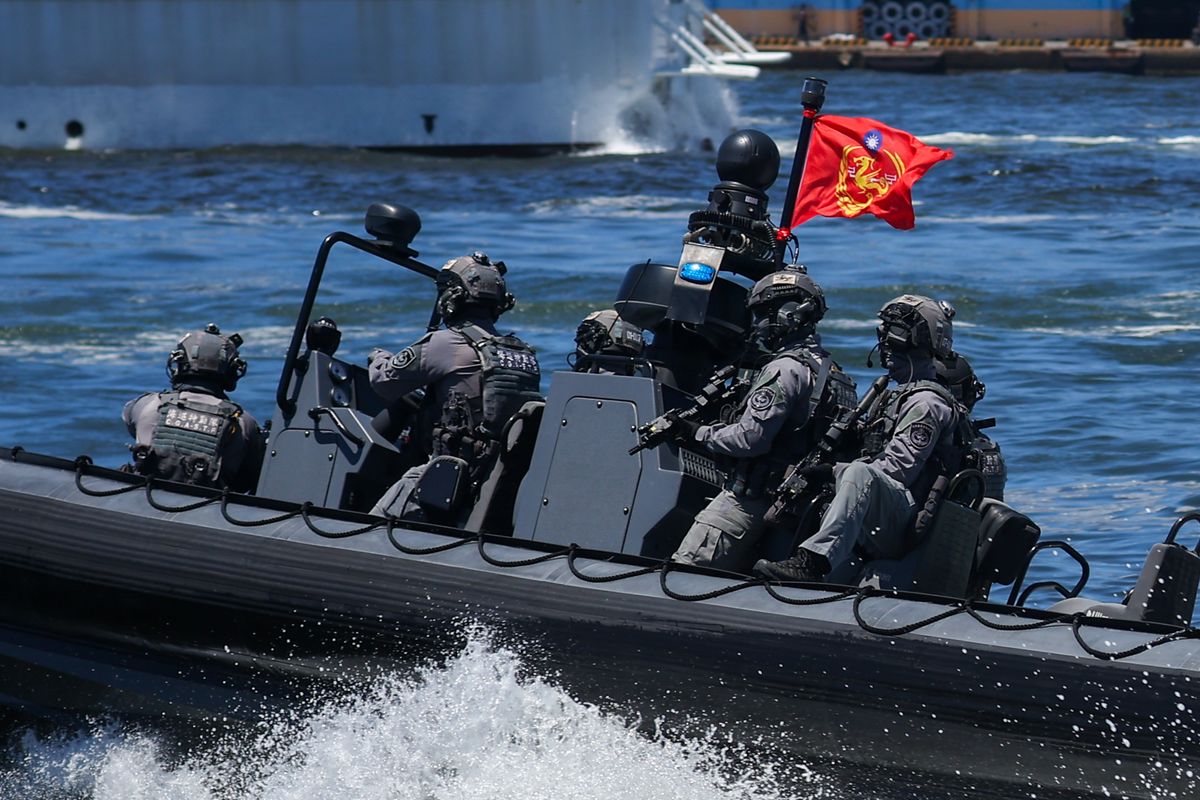Innovation is a key component of readiness when it comes to future threats. NATO’s Innovation Hub recently commissioned a short story from author August Cole, asking him to draw upon his writing and imaginative abilities to create a picture of what NATO operations could be like in the year 2040. The Cipher Brief is pleased to be able to bring you 2040: KNOWN ENEMIES, with permission from NATO.
CHAMPS-ÉLYSÉES — PARIS, FRANCE
The protestors’ braying air horns reminded Alain Durand of the feel of his father’s hand squeezing his as they watched the Tour de France peloton speed by on a verdant hill outside Chambéry, half a lifetime ago. Tonight on the Champs Elysees it meant drones. It meant gas.
He carefully pushed aside two old fashioned white cloth banners — “PAX MACHINA” and “NON AUX ARMEES, NON A LA GUERRE,” written in thick red brush strokes to better see. In a field of view populated with synthetic representations of the real world, the banners were anachronistic but also enduring. They spoke to the necessary spirit of dissent in one of Europe’s more temperamental democracies, Alain thought. Yet it was time to change again: France was the last NATO member, other than the United States, to maintain conventional combat forces. The other members had already robotized.
“A matter of not just tradition but national survival,” his father, a colonel in France’s 3e Régiment de Parachutistes d’Infanterie de Marine, always insisted.
The horns stopped. The crowd of thousands hushed to better hear the whine of the oncoming Compagnies Républicaines de Sécurité riot-police crowd-control drones, a sound like a frantically played piccolo. It was a child’s sound — that was why it intimidated. The flight of a dozen drones hovered in a picket formation in front of the crowd of more than 10,000 marching along the cobbled stones toward the Arc de Triomphe. On Alain’s augmented reality glasses, the bots were bright orange dots, tagged with comments from around the world guiding him on everything from how to download apps to jam their controllers to offers of legal representation. Alain reached into his satchel and cursed, as an ad for gas mask replacement filters popped into view.
A protestor’s drone, bright yellow and the size of an espresso cup, darted past him, then returned to hover in front of his face. It was filming. He could see the live feed it broadcast on his own glasses, identifying him as the son of a senior army officer. He looked around, feeling a need to disappear in the crowd even though that was impossible. He swatted at the yellow drone, and it darted off.
Was that a Catalyst design?, he wondered. The mysterious informal global network emerged on the public stage about three years ago, fomenting dissent and countergovernment action in the virtual realm. It started with what was essentially algo-busting or AI-enabled augmented-reality pranks to make a point about excessive Chinese and American influence around the world. But in the last six months, something had changed, and they were now moving from the online to the real world, supplying not only plans for printable grenades or swarm drones but also the fabs to make them. They had never tried to operate in Europe before, or the U.S. Was this drone a sign something was changing, literally before his own eyes?
Those same eyes began to itch. He had other things to worry about for the moment.
“Juliet, I don’t have my mask,” he said to his sister. She already had hers, a translucent model with a bubble-like faceplate that made her look like a snorkeler.
“And?” she said.
“I am certain I put it in there, but …” he trailed off.
She sighed angrily, condensation briefly fogging her mask. Four years younger, his 15-year-old sister could judge him harshly. She got that from their father.
“We stay,” she said, passing him a bandana and bottle of water. “Parliament votes tomorrow. Father is already deployed. If we leave now, when will we ever stand?”
“Ok, ok,” Alain muttered. He wet the bandana and braced himself for the gas.
Drones dashed just a few feet overhead, a disorienting swirl of straining electric motors and the machines’ childlike tone. The crowd sighed all at once and then individual shouting erupted around him. A moment later his eyes began to sting. Fumbling with the bandana he quickly wrapped the wet cloth around his mouth. But, eyes now burning, he struggled to tie it around his neck. With so much gas in the air, no one without a mask would be able any more to continue watching the eruption of digital dissent. He felt Juliet’s fingers on his neck, helping secure the bandana’s knot. Hands now free, he angrily pumped his fists in the air and blindly grasped to help hold his cloth banners aloft.
JULIUS NYERERE INTERNATIONAL AIRPORT — DAR-ES-SALAAM, TANZANIA
It was so hot, when the convoy stopped at the main gate to the joint United Nations-African Union compound, that the German and Italian battle bots broke formation. The NATO task force’s hundreds of small armored wheeled and tracked machines jerked and shimmied like ants as they fought over the shade beneath the bright blue revetments — towering stacks of shipping containers reinforced with blast-foam. That left the French para forces, what NATO classified as a light-effects company due to its mostly non-robotic composition under, in the crushing heat with nowhere to go. That was fine for the French unit’s commander, Luc Durand. His men and women could handle the heat; the bots were another story.
Captain Monika Toonce hopped off one of the oversized German Jaeger crawlers and jogged over to Durand’s open scout car. The French convoy included the jeep, six-wheeled troop carriers (each carrying 12 paratroopers as well as external racks of offensive and defensive smallbots), and four mules loaded with ammunition, spare parts, and assorted spider-like fixers.
“Colonel, we are still waiting for the clear codes before the task force can enter the compound,” Toonce said. She paused to wipe sweat from her nose. “Headquarters said they sent them. But they are not yet authenticated here …”
Durand cursed. The bots would not yet be cleared for self-defense, let alone offensive use. He forced himself to ease back and put his boot up on his jeep’s wheel well, a pose he could hold for hours on a high-speed cross-desert dash or pulling security at a vital intersection. This is an old problem in a new form, he thought. This is why the French army trains to fight with or without machines. “La victoire ne se donne pas!” was the motto adopted four years ago.
Deconflicting the newly arrived German and Italian anti-armor/aircraft and counter-personnel bots with the existing UN-AU peacekeeping forces — so that they didn’t automatically attack one another — was just another form of confusion and complexity. For all the advantage the machines offered, they also brought the onset of the fog of war forward that much earlier in a conflict. Ignoring Toonce, Durand drew with his finger on the dusty screen he wore at his waist, a series of arrows to sketch out a concept. He snapped a picture of the tracings with his glasses; it was something he would write up when he got back from deployment. You never know where inspiration will come from.
“Ok, you want to ride with us then? We are heading in. The machines can handle themselves, no?” Durand said.
Toonce looked torn between waiting with the disabled bots or accompanying Durand. Her responsibility for the German armored forces was a significant one, given the expense and competition for deployment-likely slots in the Bundeswehr. There were fewer soldiers in the German army today than there were postal carriers in Bavaria. Why they kept so many of the latter and so few of the former us was not something Toonce allowed herself to weigh too deeply. She loved the army, loved her comrades and their machines.
Toonce nodded. The maintenance techs were still on the way. She was the sole German representative, and she told herself she needed to be present when the NATO task force leaders finally presented themselves.
The two soldiers were in a narrow pause, a lull — in what had been fevered fighting — that the NATO task force had taken advantage of to deploy by air from a staging area outside Nairobi.
“Good choice,” Durand said. Toonce hopped on. Durand smiled at the master sergeant in the seat next to him, who tapped the jeep’s dash twice with the sort of gentle encouragement one might give a beloved horse. The vehicle advanced on its own at the gentle command.
They proceeded inside the compound under the watching guns of a pair of stork-legged Nigerian sentry turrets, each armed with a trio of four-barreled Gatling guns mounted on the mottled-grey fuselage pod.
Serge Martelle, the para master sergeant, handed Durand a palm-sized screen, a phone that used the local civilian networks.
“Seen this, sir?” Martelle asked.
A sigh. An image appeared of Alain’s face, jaw clenched and wide eyed, in the midst of a Paris protest. Again.
“No, not now, Martelle,” Durand said. A nod and he withdrew the screen. But Durand pulled up footage on his glasses, already tagged to his own and his son’s social media accounts. The final image was a bleary-eyed and red-faced Alain holding aloft the “PAX MACHINA.” It is Bastille Day after all, isn’t it. Durand smiled as they pulled up to a Kenyan general and his staff, standing at attention.
AU-UN HEADQUARTERS — DAR-ES-SALAAM, TANZANIA
“It’s not a mystery, as such, but we are not yet certain who is supplying the rogue Tanzanian army elements, as well as other local elements. But we can ascertain that they are currently involved in a rapid-equipping cycle using established and improvised fabrication sites that …”
“It’s Catalyst,” Durand barked. “Just call it out!” It was too easy to be rude to the UN Peacekeeping Office AIs; they were atrocious. Indecisive. Burdened with a politeness programmed to appease too many sensibilities. And that accent, unattached to any country’s native tongue, is an affront, he thought.
“Colonel Durand, analysis indicates a probability of certainty of—” the machine responded, now using a careful ethereal cadence to mollify Durand.
“General Kimani, with respect, how might we begin to engage an adversary that we refuse to identify?” Durand pressed the point. If the AU UN force acknowledged an “outbreak” of Catalyst coercive technologies, it would require an escalation of military presence that neither organization wanted to endorse at this point in the crisis.
“The last twenty-seven hours have seen no fighting,” Kimani responded. “We are hoping to use this window for dialogue.” He was the senior officer of the AUMIT, or African Union Mission in Tanzania. His charge included the military aspects of the peacekeeping mission, as well as coordinating with UN and quasi-governmental conflict-resolution groups trying to cool the conflict. “Right now, we’re running a Blue Zone dialogue with the dissident Tanzanian army, UN negotiators, Front Civil, and others. An invitation was extended to Catalyst, but no response.”
Durand nodded. Why would this highly disruptive and increasingly dangerous movement join in? It had no leaders. No clear strategy. He viewed French military intelligence’s take as sound: Catalyst sought to undermine US or Chinese economic, political, and military blocs of strategic influence to enable sub-national movements of self-determination.
The Blue Zones were private virtual environments managed by UN AIs to facilitate non-confrontational negotiations with machine-speed modelling and data. Some even talked of the platform’s AIs themselves being nominated for the Nobel Peace Prize. If Kimani really believed the UN could speed that diplomatic cycle up before the rearming of the Tanzanian coup forces then there was a chance this could resolve without further violence. Durand knew him by reputation and instinctively trusted him. Then he ground his teeth. He was being too optimistic. But what were the odds some Catalyst algos weren’t already spoofing that whole thing? It happened before, in Venezuela, in ’38. They never joined these kinds of hand-holding sims.
His watch buzzed. Toonce reported the clearance codes were finally being transmitted and would be uploaded shortly. Having the NATO mech forces inside the base would make him feel better as they could be re-checked, zeroed, and synched with the UN and AU bots already in the area of operations. NATO-reinforced UN and AU patrols could begin the next morning, he hoped. Leave the conciliation and negotiation to the UN. He had his mission.
On his glasses, Durand cued up his task force’s status reports, and began watching the downloading of the clearance codes. Details mattered, even more so with machines. As a leader you had to stay on top of it. He focused on the data and half-listened as Kimani spoke for another minute. A Rwandan officer began discussing the Belgian food fab facility near the port about to be brought online.
Blasting horns brought conversation to an abrupt stop. Half of the attendees around the table jolted upright, standing and holding the conference table with white-knuckled grips as if bracing for a bodily impact. Durand remained seated and sighed. He locked eyes with Kimani, who shook his head. An attack with a warning was one you would survive, they both knew. It’s the strikes that come without any heads up that get you.
His glasses blinked, a scratching and pixelated green snow, then returned to showing the download progress of the clear codes. Stuck at seventy-six percent. Martelle was already on his notepad, ensuring the French paras inside the compound were ready for what came next. Of course they would be, he knew. That also gave him calm.
The door burst open and Toonce paused to catch her breath. She wiped dust from her mouth and began to speak.
“The clear codes were hijacked,” she said. “Catalyst payload rode the packets, but it’s not a Tanzanian Army attack. They got partially hit, too — at least their Chinese systems, from what I can tell already. One of the local groups it looks like, based on analytics. Took the task force bots and mechs down. Same with the AU and UN already deployed here. They’re trying to bring the whole country to a stop, they say, to start real negotiations.”
“How did they attack, exactly?”“They used the clear codes to target our bots’ firmware, forcing a factory reset that requires hard keys that only exist back with the civilians at the defense ministries. We, as the deployed German army, don’t even hold those. Same with the Italians. As for the Tanzanian army systems they got from the PLA, I don’t know anything for sure, but seem to be down, too.”
That might seem fortuitous, but Durand immediately looked at it another way: If Catalyst elements could wipe out the Tanzanian army’s reliance on Chinese platforms, that would be a blank slate for a new dependence on easily downloadable and fabbable Catalyst systems. Tanzania would probably acquire the Doktor anti-armor system, a simple self-firing short-barreled launcher that could be concealed in a backpack or mounted with suction-grips to a driverless vehicle, and maybe Viper launchers, a short-range 64-shot swarm weapon about the size of a concrete block that could be held and aimed by two handles or prepositioned to strike on its own.
Nearby explosions — one, two, three — rocked the room and knocked out the lights. Sounds like mortars. In the darkness, as Durand began to taste dust in the air, he conferred with Martelle about what to do next. His paras might be the only truly friendly combat-capable force in the area right now.
CHAMPS-ÉLYSÉES — PARIS, FRANCE
Wringing out the handkerchief for a third time into the café’s brown-stained sink, Alain finally had the courage to look into the cracked mirror. Black splotches beneath the edges of the glass stained the edges of the reflective surface, framing a specter’s raw, red eyes peering back from an inky cloud.
“Oof,” he sighed. The neck of his black shirt was torn, by whom he could not remember. Claw-like scratches ran along his neck from his left ear down to his opposite clavicle. The blond girl who was shot in the legs? Or was it the CRS trooper who hit him with the mace?
A gentle knock on the door. “Everything Ok?”
That was his sister.
“A moment,” he said. He wiped his face with a coarse paper towel one more time, then put his augmented reality glasses back on. He tinted the lenses light blue. “I’m coming.”
Back out into the café, he rejoined his sister. A coffee waited, and he carefully touched its side with shaking fingers. Still warm. He closed his eyes and sipped the bitter espresso, grateful for the company of his sister and the tranquility of the café. Police drones raced by every few minutes, but no police were going to stop in here. They had other concerns right now responding to the attacks on the Champs-Élysées.
AU-UN HEADQUARTERS — DAR-ES-SALAAM, TANZANIA
Through thick black smoke, one of the tall two-legged defense turrets spun its gun mounts in lazy circles like a pinwheel. It did not fire as a swarm of bird-sized winged drones flew past in a corkscrew formation toward a far corner of the compound used for medevac flights. A series of blue strobe-like flashes followed by a sound like tearing paper meant that part of the camp would no longer be usable, Durand knew.
“Whose drones?” he asked aloud, looking around for Martelle.
“TA,” Martelle shouted, meaning “Tanzanian Army.” Normally, Martelle could look up with his glasses and get a read-out of the environment, seeing detailed information on everything from bandwidth to physical objects just as if he were going shopping. But since he had been on the base network during the attack, he saw nothing except fingerprint smudges and dust.
Yet after emerging from the bunker, the French officer knew where to find his soldiers. He sprinted at a low crouch toward a dispersed arrangement of vehicles set up in defensive positions. He greeted a soldier crouched near the rear flank of an AMX-3 armored vehicle. The paratrooper had set up a camoflage brown pop-up ballistic shield and was aiming a 10-year-old portable defense weapon skyward. These double-barreled shoulder-fired kinetic and microwave weapons were not connected to the base network or even the vehicles they were carried on, and so were still able to autonomously shoot down incoming shells and drones.
“Getting started a bit earlier than we wanted,” Durand said.
“Always ready, no?” said the soldier, whose chest armor name-plate read Orbach.
Durand held up the tablet he wore at his waist, and tapped it against the soldier’s forearm-mounted screen. Between the hastily broken up meeting and this physical connection, the mission-management AIs hosted on Durand’s tablet had created a plan of action based on years of training and real-world operations led by the colonel.
“There you go, Orbach. You have everything you need? Maybe I can fire up a fab for a nice coffee for you?”
Orbach smiled and nodded.
“Now get ready,” Durand said. “Let’s get out of this mess here and go start some trouble.”
Orders given, the information would spread rapidly from soldier to soldier, vehicle to vehicle, by direct or indirect laser transmission. Reliable, tightband, and perfect for a situation like this. Somebody might intercept it, but that was true with everything, wasn’t it?
At once, half the French paras moved to their vehicles, as the other half began climbing the shipping containers. Thanks to the task force’s own orbital sensors, unaffected by the attack so far, Durand had targets. Conventional doctrine emphasized machine vs. machine engagements, but he was going to be doing something far riskier. And more important: targeting the individuals who were the contacts, or nodes, for the Catalyst technologies. There was no time to waste staying inside the protection the base afforded. The Catalyst systems were learning and improving, from the first wave of attacks. Iterative warfare required ferocious speed and more initiative than most leaders were comfortable with.
A text message from Toonce appeared on Durand’s glasses. The UN base’s network was back up. Wait. Based on the auburn-colored text and the blue triangle icon, this was a message being sent via an encrypted consumer messaging app.
“I’m printing new logic cores for the defensive bots first, then the offensive systems. We have 213,” Toonce said.
“Of course,” Durand responded, a subvocal command converted to text. “How long?”
“Six hours.”
“And if you alternate printing, say, one defensive then one offensive, so there is … balance in our capability? I will not wait for the AU forces to regenerate. There is a window here we have to take before another round of upgrades by Tanzanian Army forces, or whoever else is equipping with Catalyst systems. We are moving out now.”
He closed out the conversation. Six hours would become 12, which would become a day delaying until the machines were ready. Durand’s paras were primed to fight now. La Victoire ne se donne pas.
Inside and atop the trucks and jeeps, the soldiers began cueing up virtual representations of their targets. The drivers took manual control, the safest option at a time like this. Less than a minute later, Durand and Martell were back in the scout car, with the commander buckling on his armor. The convoy rolled forward at a walking pace toward the base’s main gate. Some of the paras cast wary glances at the glitching Nigerian defense bots, which swayed back and forth atop their stork-like legs. Other soldiers looked for the two para sniper teams protectively watching from atop the shipping containers. As the vehicles advanced, the snipers flew a quartet of Aigle reconnaissance drones to scout routes established by Durand’s AIs.
The French soldiers were not the only ones rushing to action. Holding a water bottle in his lap, Martelle watched a squad of Kenyan infantry worked carefully to clear the medevac flight pad, guiding a pair of eight-legged explosive ordnance disposal bots as they cleared the area of micro-munitions left behind by the Catalyst swarm. The “confetti mines” were the size of an old postage stamp, paper-like explosives that detonated when their millimeters-thin bodies were bent or cracked. Coiled tight around titanium spools stored inside the bird-like drones, the mines fluttered to the ground by the hundreds, arming as they fell. One mine alone might not be enough to injure a person or even a machine. But if one detonated, it triggered other nearby mines.
“Martelle, hey,” Durand said.
“Sir,” Martelle responded, nodding. He took a drink of water.
“They have their job. We have ours.”
“Always ready. Onward,” Martelle said.
A tap on the pad at his waist and Durand urged the column forward. The base’s thick-plasticrete barrier-gates at its main entrance swung outward like arms extending for an embrace. Durand held his breath as his jeep was the first through, out into the open area beyond the base. With a feeling of regret, he passed intricate human-sized pyramids of dust-covered German and Italian bots, looking like cairns on a forgotten desert trail. It was as if in their final moments they sought to join together out of fear. He did not need those machines to complete this mission, but he would be lying to himself if he did not admit that they could make a life-or-death difference for his soldiers.
“Faster now,” said Durand. “We have our objectives, now we—”
His glasses vibrated painfully.
“MISSION ABORT,” read the message, a bright red scrawl of flashing characters.
This was no time to stop. He swiped it aside, and motioned for Martelle to keep driving.
Then General Kimani broke through with a direct audio feed.
“Colonel, you need to return to base. Mission abort. Confirm?”
There was no way to lock the officer out. Unlike with a fully autonomous formation, there was no “kill switch” for Durand’s troops. He led them, fully.
“We are en route to the objectives, general. You can see our target set; it has been approved by the task force command.”
The jeep slewed to the right, around a broken-down Tanzanian Army T-99X tank, a self-driving Chinese model that was exported throughout Africa, complete with stock PLA green-and-brown digital camo.
“No longer. PKO and AU leadership just made the call. They do not want your troops hunting down individuals in the city. Their models say it will just worsen the situation for civilians, everybody.”
Worsen? Durand thought. Isn’t it already bad enough?
“So,” said Durand. “That’s it?”
“I am going to propose another target set. Only bots, fabs, and cyber targets. No humans. We can deploy the task forces systems in six hours, I understand. Your paras can be on standby.”
Machines targeting machines, said Durand. That’s all they want any more.
He braced his leg and leaned back in his seat as his vehicle accelerated onto a deserted artery flanked by half a kilometer of torched and roofless four-story buildings. He looked back over his shoulder at the trailing convoy. His troops were there, following.
August Cole is co-author of Burn-In: A Novel of the Real Robotic Revolution
Read also How NATO is Innovating Toward the Future only in The Cipher Brief
Read more expert-driven national security insights, perspective and analysis in The Cipher Brief.













